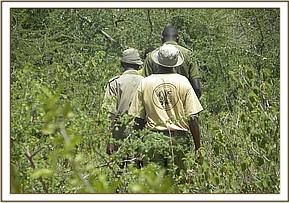Participants:
Nicodemus Kivindyo-Team Leader
John Mungai
Adan Abdi
Boru Okichi
Joshua Muthoka
2 K W S Rangers
Areas covered
During the month of April the Ziwani team conducted its de-snaring activities in the following areas; Taita wildlife sanctuary, Lualenyi ranch, Oza/Kishushe ranch and Taita ranch/Rukinga ranch.

Findings
During our operations we retrieved sixty four (64) snares all were targeting big game. Three carcasses were sighted; a zebra at Taita wildlife sanctuary, a giraffe at Lualenyi ranch and an elephant at Taita ranch, all three animals had died as a result of poaching. The zebra and the giraffe carcasses died from snares while the elephant had died after being shot by a poisoned arrow. The tusks were missing by the time we came across the carcass. We followed the poachers tracks which led us to a hideout that had been established several metres from the carcass which is an indicator that they have been living there in order to monitor the animals movements.
Observable Evidence
The April rains are still on and most of the community members are still busy in their farms leading to minimal illegal activities within our areas of operation especially snaring which is evidenced by the drastic drop on the number of snares lifted this month in comparison to other months. Nevertheless we have realised that poaching using poisoned arrows continues to take place, proof of this is the dead elephant found which had been killed using this method. The tusks were missing and an operation was launched by the team, KWS and the Rukinga wildlife sanctuary scouts in an effort to arrest the culprits. We found several hideouts which we believe are being used by the poachers and destroyed them.
Mass charcoal burning was seen to be taking place at the Taita ranch as well in other areas patrolled. We came across hideouts that are used by the charcoal burners and destroyed them.
Taita wildlife Sanctuary
This area lies under the southern part of Tsavo west National park and is home for many species of animals ranging from small game to big game as well as birds.
During our operation the team lifted forty snares all targeting big game. The snares were not newly set an indicator that snaring has decreased in this area. A zebra carcass was also found which died about two months ago after having become trapped in a snare. The poacher had not returned to the carcass to harvest the meat.
Lualenyi Ranch
This ranch lies under the southern part of Tsavo west National park and borders the allowing the wildlife to move unhindered between the two areas. During our operations in this area, the team lifted seven (7) snares all targeting big game. A giraffe carcass was also sighted which had died about three to four months ago as a result of snaring.
The flesh had been removed and carried away by the poachers evidence of this is the fact that the skin had several knife cuttings and one of the hide legs had been hidden in a nearby tree.
Logging and charcoal burning were all sighted with the charcoal burners targeting the hard woods which are preferred by the big mammals like elephants and giraffe thus posing a major threat to their survival especially during dry seasons or times of drought.
Kishushe/Oza Ranch
These areas lie under the southern part of Tsavo West National park and are an important wildlife corridor from Tsavo east to Tsavo west as well as to Tanzania and back.
The team patrolled comprehensively and were able lift seventeen snares all targeting big game.
Some of the snares lifted had been recently set which triggered the team to increase our patrols in the area during which time we retrieved some old snares which still had the potential of trapping and killing animals.
Taita Ranch/Rukinga Ranch
These areas lie under Tsavo East National park and are a home to many species of animals and more important a home to the endangered grevy zebra which were introduced to Tsavo east in 1964 from the Samburu game reserve and Mt Kenya game ranch for tourism purposes and have a good home here.
During our operations in these areas the team found an elephant carcass which had been killed by poachers using poisoned arrows. The tusks had been removed and the carcass had been left untouched by scavengers, another indication that poisoned animals had been used to kill this magnificent animal.
Several hide outs were found which we suspect had been used by the poachers while waiting to kill the elephant or other wildlife. Evidence of this is the fact that the poachers tracks led to the hideouts. The hideouts were destroyed as were others suspected to be used by charcoal burners.
Community work
The month of April did not have many community outreach programmes being carried out as the schools were closed. Nevertheless we participated in the international year of biodiversity hosted at Mwatate on 3rd of April. The team leader (Nicodemus Kivindyo) was the adjudicator of all the events presented on that day.
Report by Nicodemus Kivindyo




















